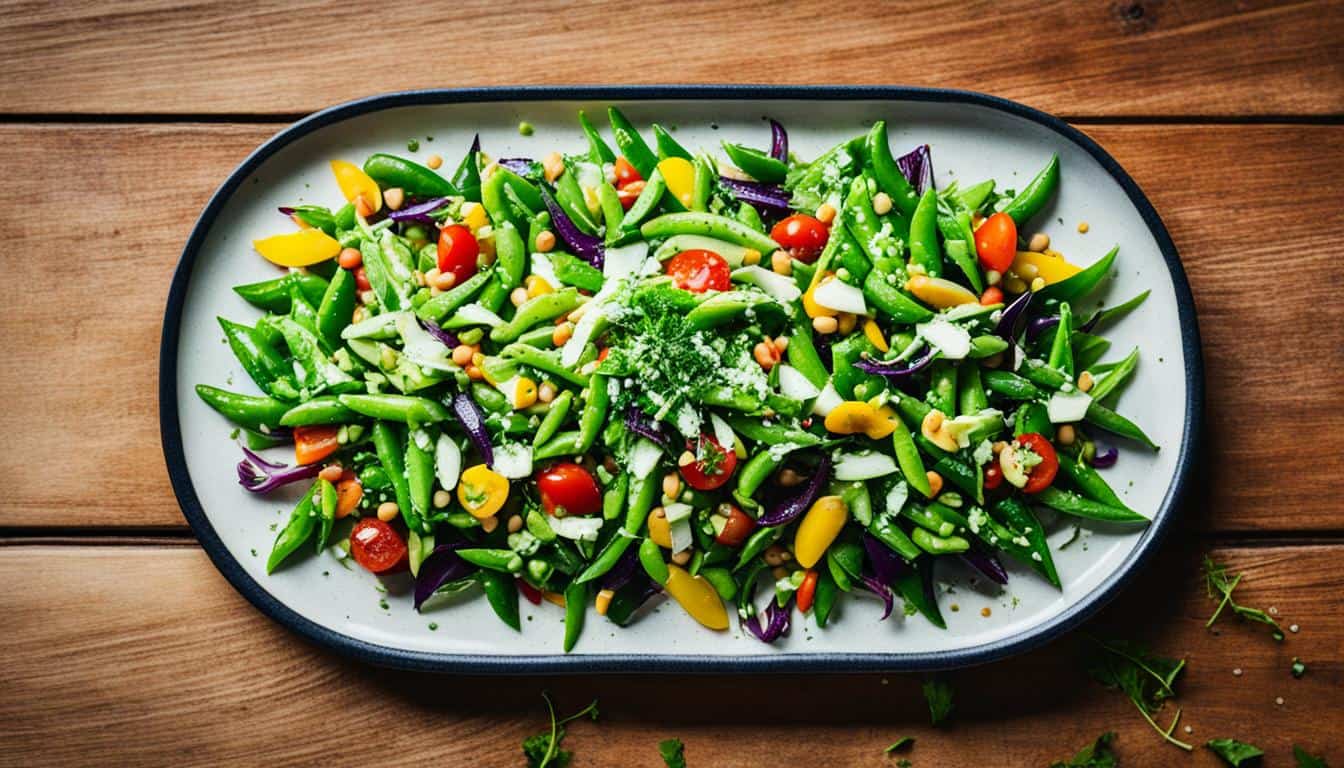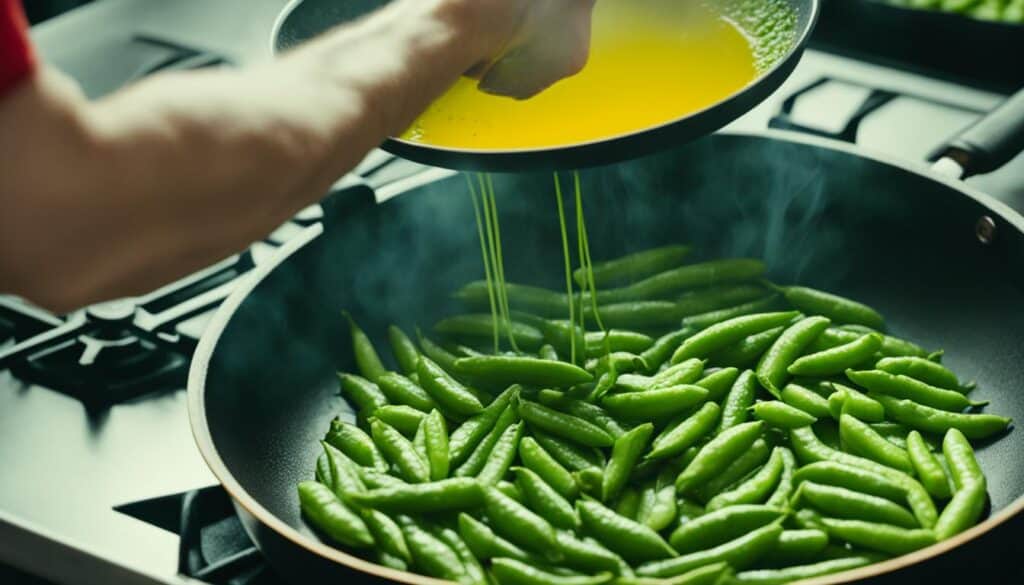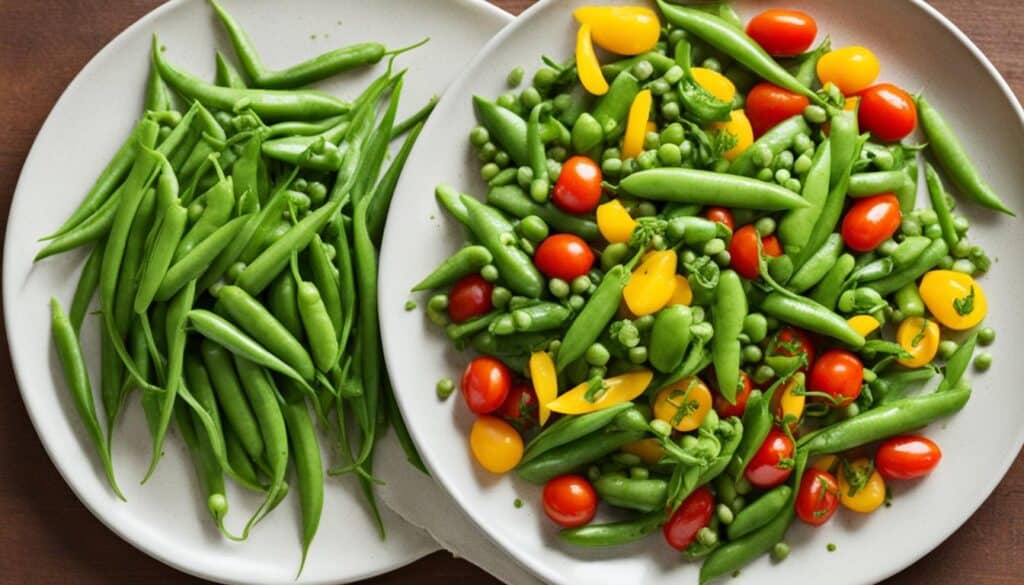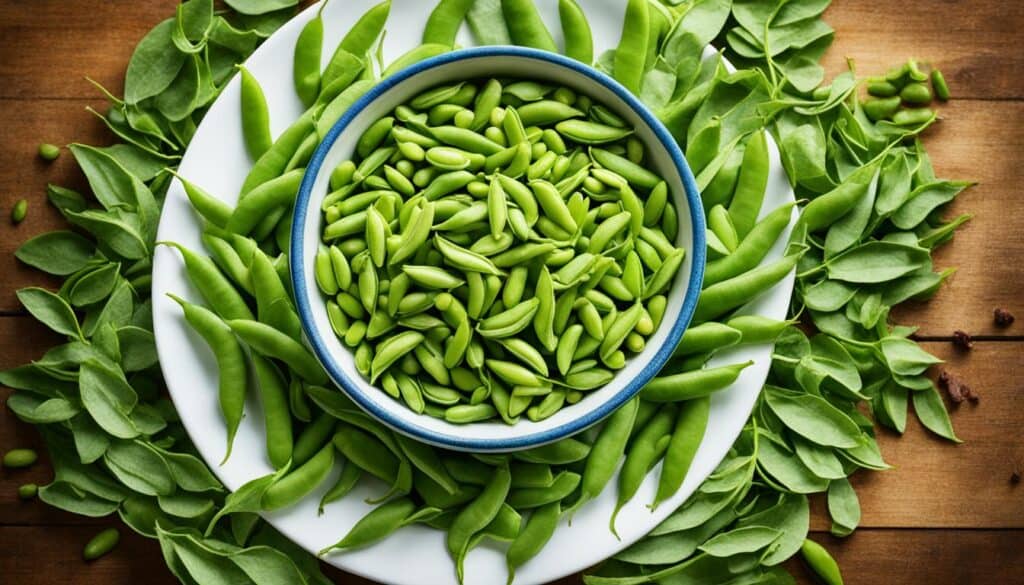Did you know that winged bean, a tropical legume, packs a nutritional punch that rivals some of the most popular superfoods? These plant-based powerhouses are not only rich in protein, fiber, vitamins, and minerals, but they also offer a range of health benefits that can boost your wellbeing. Plus, they are incredibly versatile in the kitchen, making them a must-try ingredient for any culinary enthusiast.
In this comprehensive guide, I’ll take you on a journey through the world of winged beans. From their impressive health benefits to mouthwatering recipes, you’ll discover why this lesser-known legume deserves a place on your plate. So, let’s dive in and uncover the hidden potential of winged beans.
Key Takeaways:
- Winged beans are a tropical legume known for their impressive nutritional content.
- These legumes are rich in protein, fiber, vitamins A and C, iron, and calcium.
- Health benefits of winged beans include boosting immunity, promoting healthy eyes, aiding digestion, supporting muscle growth, promoting bone health, and preventing diabetes.
- They can be used in a variety of delicious recipes, such as stir-fries, soups, and salads.
- Winged beans can be found in tropical markets year-round and are cultivated in small farms and home gardens.
Winged Bean Selection and Storage
Exploring the World of Winged Beans
When it comes to winged beans, there is so much to discover. These versatile legumes can be found in tropical markets all year round, under various names such as “kacang botol” in Malaysia and “kecipir” in Indonesia. While their cultivation is still limited to small farms and home gardens, their popularity continues to grow.
If you’re interested in growing your own winged beans, it’s important to understand the selection and storage process. When choosing winged beans, look for tender, immature pods that have a shiny green surface and light green chewy peas inside. Avoid overmature and discolored beans as they may not offer the same nutritional value.
Once you’ve handpicked your winged beans, it’s crucial to know how to store them properly. To keep them fresh, store the beans in a plastic bag in the refrigerator. This method can extend their shelf life for up to four days.
| Keyword | Information |
|---|---|
| Winged Bean Cultivation | Primarily cultivated in tropical regions with hot, humid climates. |
| Growing Winged Bean | Requires a trellis for support and well-drained sandy loam soil. |
| Winged Bean Farming | Still limited to small farms and home gardens. |
| Winged Bean Nutrition | Rich in nutrients such as protein, fiber, vitamins A and C, iron, and calcium. |
Now that you know how to select and store winged beans, you can confidently incorporate these nutritious legumes into your meals. Up next, we’ll explore different methods of preparing and serving winged beans, ensuring you unlock their full potential in the kitchen.
Winged Bean Preparation and Serving Methods
When it comes to preparing and serving winged beans, there are plenty of options to explore. Let’s dive into some exciting ways to incorporate this versatile legume into your meals.
Cleaning and Trimming
To start, make sure you wash the winged beans thoroughly in cold water. This removes any dirt or impurities. Trim off the tip ends of the beans for a tidy presentation.
Chopping and Slicing
You can chop the winged beans diagonally into small sections, which are perfect for various recipes. These bite-sized pieces offer a great texture and flavor in each dish.
Adding to Salads and Stir-Fries
The young pods of winged beans are a delicacy in South and Southeast Asian cuisines. You can add them to salads for a refreshing crunch or incorporate them into stir-fries for a burst of flavor. They complement other vegetables beautifully.
Grilled Immature Pods
For a unique twist, try grilling whole immature pods of winged beans. Season them with a drizzle of oil, salt, and pepper. The result is a smoky, tender, and flavorful dish that will impress your taste buds.
Roasting Winged Bean Seeds
Don’t forget about the seeds! Roasting winged bean seeds is a fantastic way to add nuttiness and crunch to your meals. You can sprinkle them on salads or include them in stews for added texture and flavor.
Cooking with Tender Greens and Shoots
Another part of the winged bean plant that is often overlooked is its tender leafy greens and shoots. These can be cooked in stews and stir-fries, adding a vibrant green color and a pleasant, earthy taste to your dishes.
A Popular Winged Bean Recipe: Ginataang Sigarilyas
“Ginataang sigarilyas is a popular Filipino dish that showcases the delicious combination of winged beans, creamy coconut milk, and spicy chili peppers. This savory recipe is a perfect example of how winged beans can be used to create a flavorful and satisfying meal.”
Remember to explore and experiment with other recipes that incorporate winged beans. The possibilities are endless, and you’re sure to discover new and exciting flavors along the way.
| Preparation Methods | Best Used In |
|---|---|
| Chopped Diagonally | Stir-fries, salads |
| Grilled Immature Pods | Appetizers, side dishes |
| Roasted Winged Bean Seeds | Stews, salads |
| Cooked Tender Greens and Shoots | Stir-fries, soups |
Try these methods and explore your own culinary creations using winged beans. Let your imagination take flight with this versatile and nutritious legume.
Winged Bean Safety Profile
When it comes to consuming winged beans, it is important to be aware of their safety profile. While winged beans are generally safe for healthy individuals, there are a few considerations to keep in mind.
Allergies and Contraindications
Individuals with known immune allergies to legumes should exercise caution when it comes to consuming winged beans. Allergic reactions can vary in severity and may include symptoms such as itching, swelling, hives, or difficulty breathing. If you have a history of legume allergies, it is advisable to consult with a healthcare professional before including winged beans in your diet.
Furthermore, individuals with G6PD-enzyme deficiency disease should avoid winged beans. G6PD deficiency is a genetic condition that affects the red blood cells, causing them to break down in response to certain triggers, including certain legumes.
Oxalic Acid and Urinary Tract Stones
Winged beans contain oxalic acid, which has been associated with the formation of oxalate stones in the urinary tract for some individuals with known oxalate urinary tract stones. Oxalate stones can cause pain and discomfort and may require medical intervention. To minimize the risk of stone formation, it is recommended to maintain adequate hydration by drinking enough water throughout the day.
It is important to note that these precautions apply to specific groups of individuals, and for the majority of people, winged beans can be enjoyed as a safe and nutritious addition to a balanced diet.
Winged Bean Nutrition Facts
When it comes to nutrition, winged beans are a powerhouse. These legumes are not only low in calories but also packed with essential nutrients that contribute to a healthy diet.
Here are the nutrition facts of winged beans per 100g (3.5 ounces):
| Nutrient | Amount |
|---|---|
| Calories | 49 |
| Fat | 0.8g |
| Carbohydrates | 4.3g |
| Fiber | 8g |
| Protein | 6.9g |
Winged beans are also rich in vitamins and minerals. They are particularly high in vitamins A and C, with over 18 mg of vitamin C per 100g. Vitamin A supports healthy eyesight, while vitamin C acts as an antioxidant that boosts immunity.
Additionally, winged beans contain folate, an important nutrient for brain health, and tryptophan, which helps reduce headaches and lower stress levels.
Winged Bean Cooking Methods
When it comes to cooking winged beans, there are various methods you can try to bring out their delicious flavors. Here are some popular ways to prepare and cook winged beans:
Sautéed Winged Beans
If you’re looking for a quick and easy way to cook winged beans, sautéing is a great option. Heat some oil in a skillet, add minced garlic, and cook the beans for a few minutes with water. This method allows the beans to retain their crispiness while absorbing the flavors of the garlic and oil.
Steamed or Boiled Winged Beans
For a healthier cooking method, you can steam or boil winged beans. Steaming them for 3-5 minutes or boiling them for 2 minutes will help preserve their nutrients while softening their texture. Once cooked, you can enjoy them as a side dish or incorporate them into other recipes.
Baked Winged Beans
If you prefer a roasted flavor, try baking winged beans. Slice the beans, drizzle them with oil, and bake them in the oven for about 10 minutes. This method enhances their natural flavors and gives them a slightly crispy texture.
Regardless of the cooking method you choose, don’t forget to season the winged beans with salt, pepper, and other desired spices to enhance their taste. Be creative and experiment with different seasonings to find your favorite flavor combination!
Now that you know some cooking methods for winged beans, let’s explore some delicious recipes in the next section.
Winged Bean Tips and Serving Suggestions
When picking winged beans, look for bright green pods that are firm and free from brown or black spots. These vibrant green pods indicate freshness and ensure the best flavor and texture.
Once you have selected your winged beans, it’s time to prepare them for your delicious creations. Start by cleaning the beans, removing any dirt or debris, and trimming the ends if necessary.
For optimal presentation and ease of cooking, slice the winged beans diagonally into small sections. This not only enhances their visual appeal but also ensures even cooking and allows for better flavor absorption.
Winged beans are commonly used in Indonesian, Malaysian, Vietnamese, and Cambodian cooking. Their unique taste and texture make them a versatile ingredient in various dishes.
Here are some serving suggestions and ways to incorporate winged beans into your meals:
- Add winged beans to stir-fries: Their crispness and mild flavor make them an excellent addition to stir-fried dishes. Combine them with your favorite vegetables, protein, and sauce for a delightful and nutritious meal.
- Include winged beans in soups: The crunchy texture of winged beans adds a pleasing contrast to soups. Their mild flavor allows them to complement different soup bases and ingredients for a hearty and healthy bowl.
- Use winged beans in salads: Slice the beans thinly and toss them into salads for a vibrant pop of color and crunch. They add a unique touch to your salads and provide valuable nutrients.
- Serve winged beans as a side dish: Prepare winged beans as a side dish alongside seafood or poultry. Their versatility allows them to pair well with a wide range of main courses, enhancing the overall dining experience.
For added depth of flavor, winged beans can be paired with ingredients such as coconut milk, chili peppers, garlic, ginger, or various spices. These flavor combinations create a harmonious blend that elevates the taste of your dishes.
Incorporating winged beans into your cooking repertoire opens up a world of culinary possibilities. Experiment with different recipes and cooking methods to discover new ways to enjoy this nutritious legume.
Winged Bean Cultivation and Availability
Winged beans thrive in tropical regions with hot and humid climates. They require a trellis for support and well-drained sandy loam soil to grow successfully. Cultivating winged beans can be done in small farms and home gardens.
“Cultivating winged beans is a rewarding experience, especially if you have a passion for farming. With proper care and attention, you can grow a bountiful harvest of winged beans right in your backyard.” – Expert Farmer
Although winged bean cultivation is currently limited to small-scale farming, these nutritious legumes are available in tropical markets throughout the year in regions where they are grown.
Benefits of Winged Bean Farming
There are several advantages to growing winged beans:
- High Yield: Winged beans are known for their high productivity, allowing farmers to obtain a substantial harvest from a relatively small area of land.
- Nutrient-Rich Soil: Winged beans are nitrogen-fixing plants, meaning they convert atmospheric nitrogen into a form that can be utilized by other plants in the soil. This improves soil fertility and reduces the need for synthetic fertilizers.
- Drought Tolerance: Winged beans have good tolerance to drought conditions, making them a suitable crop for regions with limited water availability.
- Economic Opportunities: With the increasing demand for healthy, plant-based foods, there is a growing market for winged beans. Farmers can capitalize on this demand and create profitable business opportunities.
By cultivating winged beans, you not only contribute to your local food supply but also support sustainable farming practices that benefit the environment.
| Region | Climate | Availability |
|---|---|---|
| Tropical regions | Hot and humid | Year-round |
By offering a consistent supply of winged beans, tropical markets enable consumers to enjoy the nutritional benefits of these versatile legumes regardless of the season.
The Versatility of Winged Beans
Winged beans are highly versatile and can be used in various dishes. Whether you’re looking to add a nutritious crunch to stir-fries, enhance the flavors of soups, or create fresh and crunchy salads, winged beans are a perfect choice. Their sweet, chewy, and earthy flavor is popular in South and Southeast Asian cuisines, making them a staple ingredient in traditional dishes.
You can experiment with winged beans in innovative ways by adapting them to create new recipes. One option is to grill them, allowing their unique flavor to develop a smoky and charred profile. Another method is roasting them, which intensifies their natural nuttiness and adds a depth of flavor. For a simple and healthy side dish, winged beans can also be steamed, preserving their crunchiness and allowing their delicate taste to shine.
Winged Bean Recipe Ideas
Here are a few recipe ideas to inspire you to incorporate versatile winged beans into your cooking:
- Stir-Fry: Create a vibrant and nutritious stir-fry by combining winged beans with other vegetables like bell peppers, carrots, and snap peas. Sauté them in a hot wok with garlic and ginger, and add a flavorful sauce of your choice.
- Sambal Salad: Toss blanched winged beans with a spicy sambal dressing, cherry tomatoes, cucumber, and fresh herbs for a refreshing Indonesian-inspired salad.
- Grilled Winged Beans: Marinate winged beans in a mixture of soy sauce, lime juice, and honey. Grill them on skewers until charred and caramelized, and serve as a tasty appetizer or side dish.
- Winged Bean Soup: Add winged beans to a hearty vegetable or chicken soup for an extra crunch and a boost of nutritional value.
These are just a few examples of the versatility of winged beans. Feel free to explore and experiment with different cooking methods and ingredients to create your own unique winged bean recipes.
| Winged Bean Recipe | Cooking Method | Preparation Time |
|---|---|---|
| Stir-Fried Winged Beans with Vegetables | Sauté | 15 minutes |
| Sambal Winged Bean Salad | Toss and mix | 20 minutes |
| Grilled Winged Beans | Grill | 25 minutes |
| Winged Bean Soup | Boil | 30 minutes |
Conclusion
Winged beans are a nutritious and versatile legume that offer a wide array of health benefits. Incorporating winged beans into your diet can help boost your immunity, promote healthy eyes, aid digestion, support muscle growth, and promote bone health. Not only are winged beans beneficial for your wellbeing, but they are also incredibly versatile in the kitchen.
With the numerous cooking methods and serving suggestions available, you can easily incorporate winged beans into a variety of delicious recipes. Whether you’re looking to explore new flavors or enhance the nutritional value of your meals, winged beans are a fantastic choice. From stir-fries and soups to salads and side dishes, there are endless possibilities for incorporating winged beans into your culinary repertoire.
So why wait? Start reaping the benefits of this unique and nutritious legume by trying out winged bean recipes today. Whether you’re a seasoned chef or a novice in the kitchen, winged beans are sure to add a burst of flavor and nutrition to your meals. Don’t miss out on the health benefits and culinary delights that winged beans have to offer!










Leave a Reply